“Toxic backlinks” sound scary. Can other sites, just by linking to you, ruin your SEO?
The dangers of toxic links are real. However, diagnosing the issue takes skill and knowledge.
In this article, we’ll share what you need to know about toxic backlinks and how to protect yourself.
First, let’s start with a definition.
In This Article
What are Toxic Backlinks?
Toxic backlinks are links from other sites to yours, created as part of a link scheme.
Typically, a website owner has paid a seller for these links. The goal is to manipulate rankings.
Remember: backlinks are a significant ranking factor. But only backlinks from trustworthy, quality sites will impact SEO positively.
Links from questionable sites can negatively impact your SEO. And this is where the problem starts.
There are lots of individuals and businesses selling backlinks. These sellers typically place links on “splogs” – short for “spam blogs.” These are low-quality sites that exist only to sell links.
Many splogs are part of PBNs, private blog networks. These networks are collections of splogs linking to one another and to their paying clients.
Google is very good at identifying splogs, PBNs, and link schemes.
If your site is identified as having participated in a link scheme, Google may penalize you. And this can harm your SEO.
What’s a link scheme? It’s using backlinks, particularly paid links, to rank higher.
Here’s what Google Analyst John Mueller has said on the topic:
. . . [A]rtificially building links, dropping links on other sites, buying links, all of that is against the webmaster guidelines.
And the actions that we take include demoting the site that is buying the links, demoting the site that is selling the links.
Paying for backlinks to manipulate rankings is against Google guidelines.
What’s the Source of Toxic Backlinks?
So, how do website owners get caught up in these link schemes?
There are 3 main avenues.
- Low-cost link sellers
- Cold outreach emails
- Inexperienced marketers
Let’s look at each one so you know what to avoid.
1. Low-Cost Link Sellers
If you have enabled comments on your website, you know why moderating them is essential. Most sites, especially WordPress sites, are flooded with spammy comments as soon as they go live.
And plenty of these spam comments include links. Upstream, someone has sold a site owner a package, “X Links for X dollars.” The sellers often place these links in comment sections. Many of those comments never get published.
Moral of the story: If it sounds too good to be true, it probably is. Don’t buy comment links.
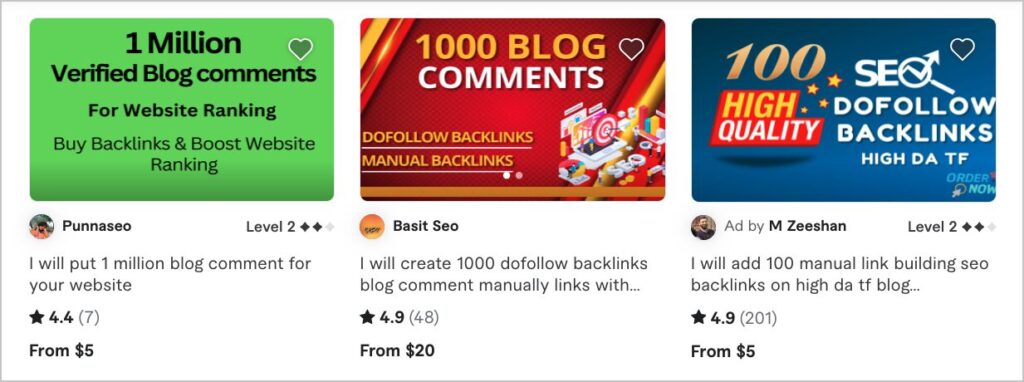
2. Cold Outreach Emails
Link sellers often pitch site owners via cold emails offering “high-quality backlinks” on “high-DA” sites.
The email will often include a link to a Google Sheets pricelist with a dozen or more sites, along with their DA score and link costs.
DA stands for “domain authority.” These scores, out of 100, are intended to serve as a proxy for quality.
Created by keyword software companies like Ahrefs and Semrush, domain authority (or “domain rating”) scores are proprietary. And they’re measured on a logarithmic scale. So, 50 is a very good score.
While domain scores rely heavily on a site’s backlink profile and can be helpful, they’re not perfect metrics.
To the point, when a “high DA” domain goes up for sale, a PBN may buy it and fill it with spammy content. Then, they contact site owners, offering links on a “high DA” website.
Cold outreach emails of this type offer these services:
- You’re invited to guest post for their site and can include a dofollow link
- You can pay for a link to be inserted into their current content
- They’ll write the guest post for you and insert a link
3. Inexperienced Marketers
A third way site owners may get tangled up in link schemes is by hiring a marketer who doesn’t know better.
These marketers convince you of the value of paid links. Once they get a budget, they start buying backlinks from PBNs.
Worse, they may replicate exact match money anchors across the splog-o-verse, sending red flags to Google.
How Do Toxic Links Impact SEO?
If you have toxic links pointing to your site that are part of a link scheme that you initiated, you can incur a Google penalty.
This is true even if your site gets a temporary rankings boost from the links.
Manual Actions
The Google penalty is called a manual action. If you get a manual action, you’ll find out about it via your Google Search Console account.
In short, Google uses “automated systems” and “human review” to assess manual actions.
Negative Impact on Rankings and Indexing
What’s the penalty? “Sites that violate our policies may rank lower in results or not appear in results at all.” (Source: Google spam policies.)
Getting a manual action is like a referee taking you out of a game.
Low-Quality Links vs. Toxic Backlinks
Toxic backlinks are understandably referred to as low-quality links. But not all low-quality links are harmful. It’s all in how you define “low-quality.”
Remember the DA score? Don’t mistake backlinks from websites with low DA scores (even of 0 or 1) for toxic links. A career professional or “mommy blogger” who just launched a website may have a low DA score.
In fact, it’s common for sites to have referring domain profiles weighted heavily in the 0-10 range.
Case in point: look at this Semrush referring domains data for Wired magazine. Most of the referring domains (427,134) have a Domain Authority score of 0-10.
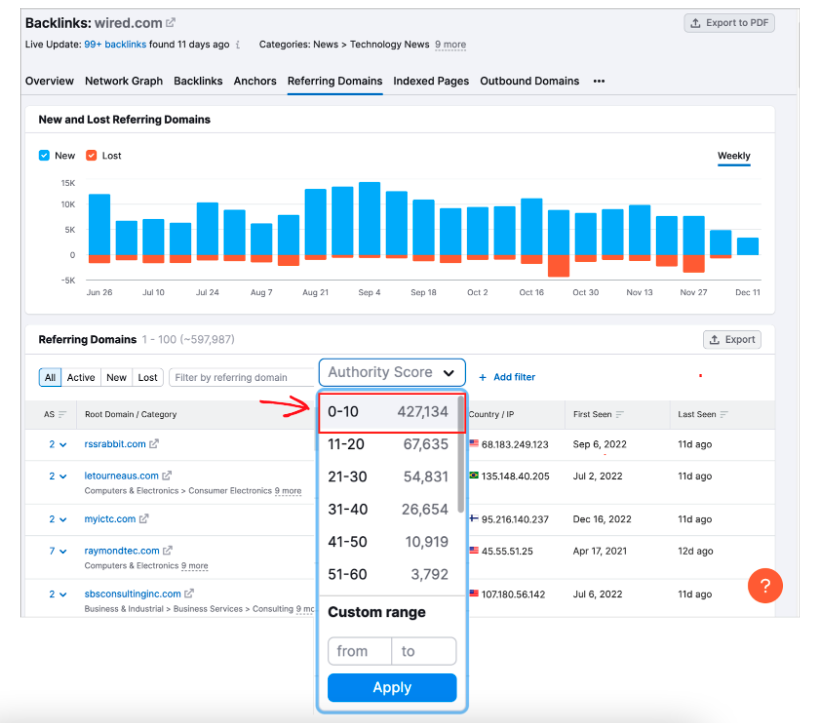
Remember, toxic links are links you paid for from sites that only exist to sell links. They become “toxic” once Google detects patterns that indicate a link scheme, such as excessive use of money anchors.
Paid links from illegal drug sites, gambling sites, sites involved in fraud, and unvetted binary options sites can also harm your site’s SEO.
Remember, the easiest way to avoid link scheme penalties is to never pay for backlinks.
Indeed, most site owners will never have to deal with toxic backlinks.
But if you’ve inadvertently gotten caught up in a link scheme, here’s what you need to know.
When to Take Action
Only if you’ve been involved in link schemes, or the previous owner of your domain was, should you consider taking action.
In short, take action if you receive a manual action from Google or are at risk of receiving one.
Disavowing Toxic Backlinks
The action you’ll take is to disavow the toxic backlinks.
Disavowing links is done by listing them on a spreadsheet according to Google’s instructions and uploading the sheet to Google Search Console GSC).
- The spreadsheet is called a disavow file.
- Google’s disavow tool is inside GSC.
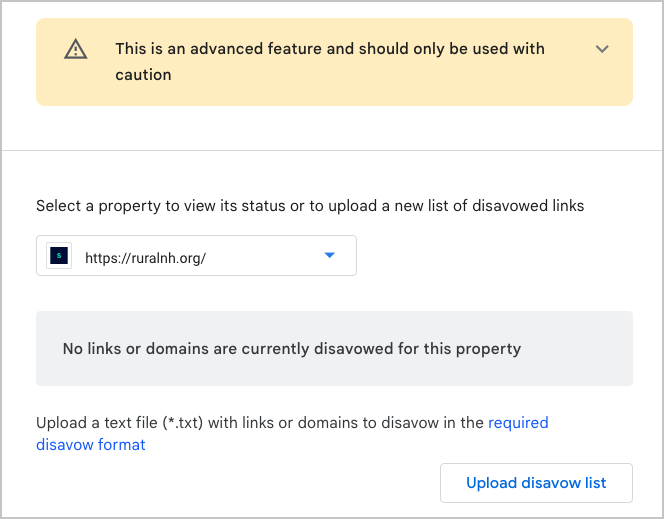
However, we recommend that you leave disavowal to an SEO professional. Why? If the disavowal is done incorrectly, you could further harm your SEO.
An SEO professional will likely conduct a backlink audit before disavowal. They’ll review your link profile for evidence of spammy links coming from link farms as well as unnatural link patterns.
Backlink audit tools include Semrush, Ahrefs, and Ubersuggest.
A key part of the process is to identify the toxic backlinks correctly. This isn’t as easy as it may sound. Consider: some sites that look spammy aren’t splogs. And some websites that look legitimate are, in fact, PBNs.
And Google has warned against disavowing links that aren’t part of a link scheme you initiated.
The point of disavowal is to identify links originating in a scheme you actively participated in.
Often, after your guest post is published by one of these paid services, it gets copied and posted to a dozen or more other sites the seller controls, as well. So those links need to be identified too.
While there are software tools, like Link Research Tools, that can assist in disavowal, those tools are best left to pros as well.
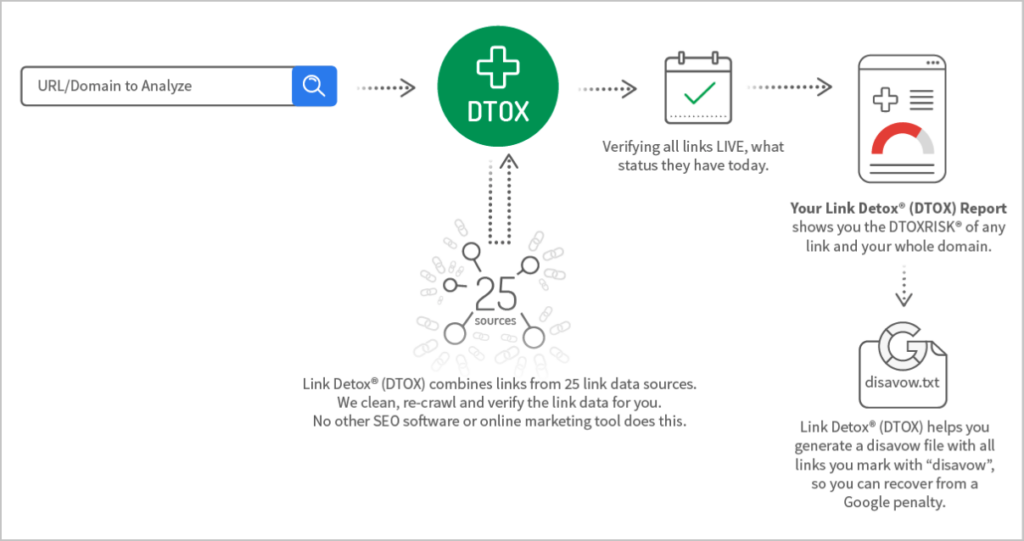
Reconsideration Request
After you fix the issues that led to a manual penalty you can ask Google to lift that penalty. In Google Search Console, you’ll select Request Review to do this.
There’s no guarantee that your penalty will be lifted. For instance, a site owner, who knowingly got involved in a paid link scheme, received a manual penalty, then hired a professional to help.
After 6 reconsideration requests, there was “zero progress.”
Now that you know how to avoid toxic backlinks and what to do if you get caught up in a link scheme, what can you do to acquire quality backlinks?
How to Build Quality Backlinks
The best way to get high-quality backlinks is to publish helpful content optimized for search engines.
Optimizing content helps others find it. And once people find quality content, they naturally share it with others.
Focus on quality rather than number of backlinks.
Yet realize that backlinks can snowball: the more backlinks, the higher your rankings, and the more people discover and link to you.
For many sites, acquiring a handful of backlinks while continuing to publish optimized content leads to a hockey-stick growth pattern.
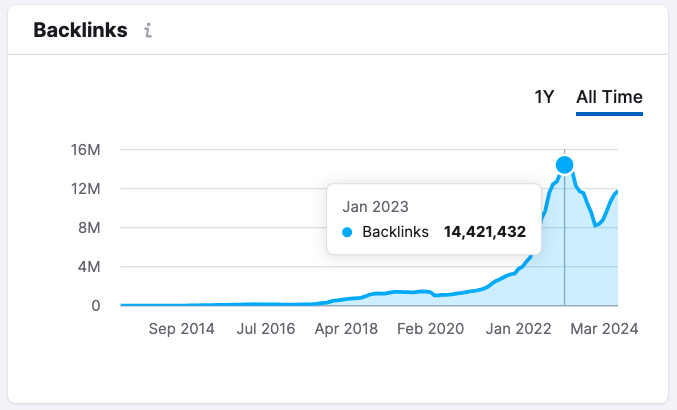
“Nofollow” links, no matter their origin, confer no SEO value or PageRank. Find out the difference between nofollow and dofollow links.
How to Optimize Your WordPress Content
So, how do you optimize your content for improved search engine rankings?
WordPress users can use an SEO plugin. We recommend All in One SEO (AIOSEO).
All in One SEO is an established plugin with thousands of 5-star reviews on WordPress.org. Currently, over 3 million people are using the plugin.
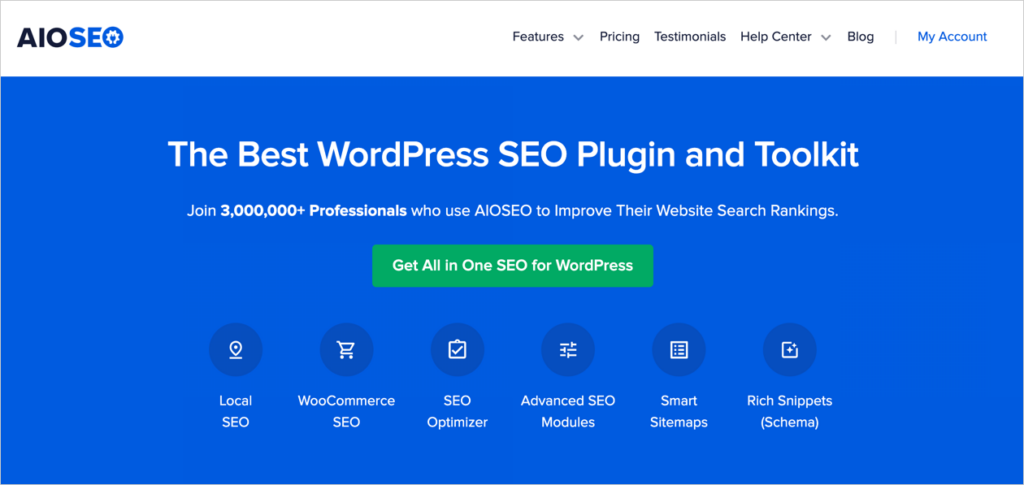
This plugin analyzes your pages and provides specific instructions for improving your SEO. This removes a lot of the guesswork from optimizing your content.
The recommendations are visible in the AIOSEO sidebar. Just click a tab (like “Basic SEO”) to get instructions.

In addition, the plugin automatically manages technical aspects of your SEO.
Here are some of the most useful features.
- Automatic Sitemaps: AIOSEO automatically generates sitemaps, following Google’s best practices. Whenever you modify content or publish new pages, AIOSEO updates your sitemaps for you.
- TruSEO Analysis: AIOSEO analyzes every page on your site, giving you an SEO score for each. Follow the plugin’s action steps and see your SEO score increase.
- Schema Generator: Add schema markup to your pages easily. This code helps search engines understand your content and rank it for relevant keywords.
- Link Assistant: Adding internal links to your most important pages can help them rank higher. This tool makes it easy to build those links.
- Search Statistics: See which keywords you’re ranking for without leaving WordPress. You can also see how Google algorithm updates impact your site.
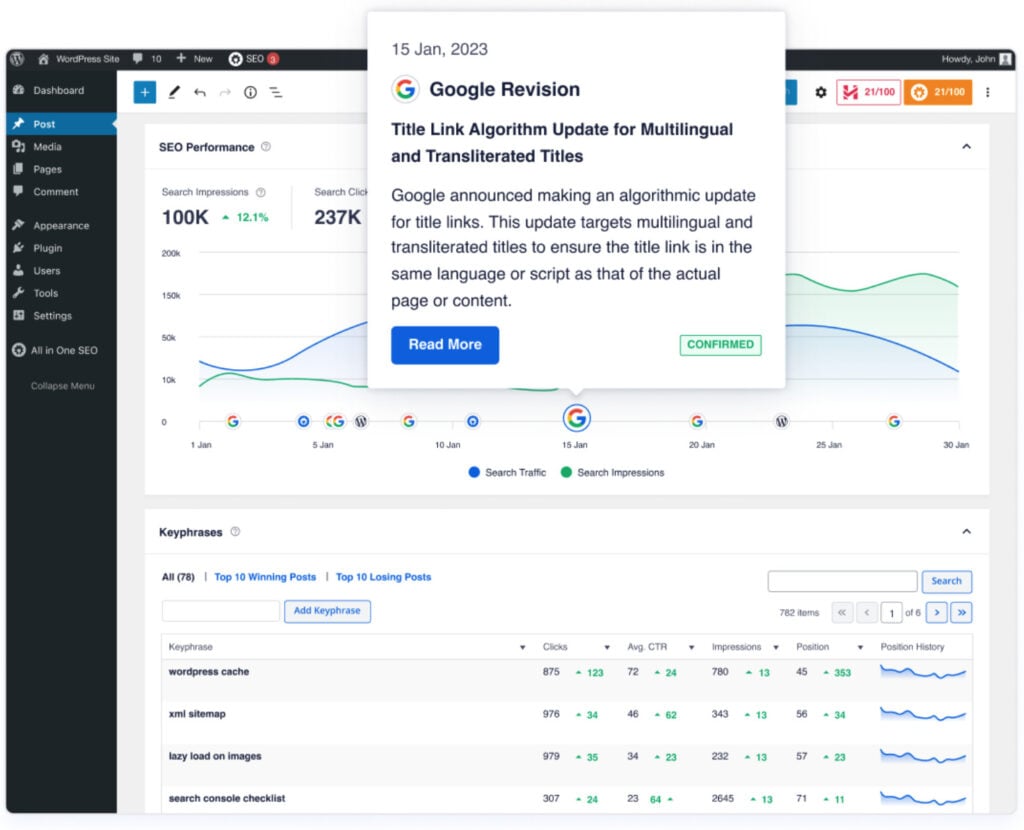
When local businesses get listed in directories, those listings provide a headstart in acquiring good backlinks.
Major Google Algorithm Updates That Targeted Toxic Backlinks
Identifying link schemes has long been a focus of Google Search. There have been several Google algorithm updates over the years that focused on identifying and penalizing websites with spammy or low-quality backlinks.
Here are some of the most notable ones:
| Update Name | Launch Year | Description |
|---|---|---|
| PageRank | 1998 | PageRank, created by the founders of Google, was a core part of its early ranking algorithm. It used the quality and quantity of links pointing to a webpage to determine its importance and authority. Although it has evolved over time, the principles of PageRank laid the foundation for Google’s approach to evaluating backlinks. |
| Google Penguin | 2012 | This update targeted websites that engaged in manipulative link building practices, such as buying links or obtaining links through link networks, in order to artificially boost their search rankings. Penguin aimed to decrease the search rankings of websites that violated Google’s quality guidelines. |
| Penguin 2.0 | 2013 | This update was a more advanced version of the original Penguin algorithm. It went deeper into websites’ link profiles to identify and penalize sites with spammy or manipulative backlinks. |
| Penguin 3.0 | 2014 | This update was a refresh of the Penguin algorithm, impacting fewer websites than the previous versions. |
| Penguin 4.0 | 2016 | This update made Penguin a part of Google’s core algorithm, meaning it runs in real-time and continuously updates. This version also made the algorithm more granular, devaluing spammy links rather than penalizing entire websites. |
While not specifically targeted at spammy backlinks, other algorithm updates like Panda (which focused on content quality) and the “Payday Loan” update (which targeted spammy queries) also had an impact on websites with low-quality or manipulative backlink profiles.
The Penguin algorithm has since been incorporated into Google’s core algorithm and continues to identify and devalue spammy links in real-time.
Q&A on Toxic Backlinks
Does Google penalize backlinks?
Google doesn’t penalize backlinks per se; it penalizes sites engaged in link schemes. In other words, these are schemes initiated by a site owner. These schemes reveal backlinking and anchor text patterns that Google can detect.
Which backlinks are most powerful?
The most impactful backlinks for SEO are those from authoritative, trusted websites. These include government, news, university, and medical research websites.
More on Backlinks
To recap, site owners should avoid paying for spam links in order to manipulate Google rankings. In addition, any organic traffic gained will likely be of poor quality.
Instead, cultivate a link building strategy based on producing quality content.
If you’ve made a mistake, and have received a manual penalty from Google, tread carefully when disavowing backlinks. Consider hiring a professional.
Now that you know what toxic backlinks are and why you should avoid paid links, what’s next?
- Learn more about the power of backlinks to drive rapid SEO growth and website valuations.
- Get actionable ideas from our link building guide.
- Explore our Trends section, which features case studies of websites that have achieved rapid growth. These websites often feature a strong backlink profile.
- Discover the crucial differences between SEO and social media in digital marketing.
- And check out these free SEO tools: the price is right!
Then subscribe to our YouTube Channel for new tutorials every week. And join us on X (Twitter), LinkedIn, or Facebook to stay in the loop.
Disclosure: Our content is reader-supported. This means if you click on some of our links, then we may earn a commission. We only recommend products that we believe will add value to our readers.

